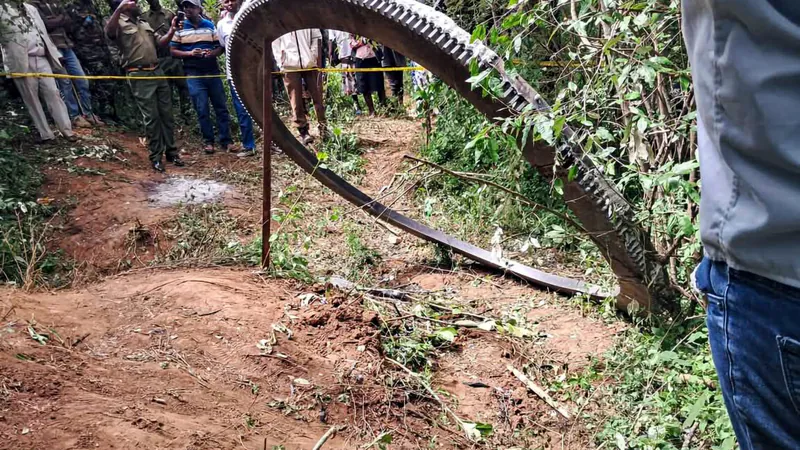
Mysterious Metal Ring Falls from the Sky in Kenya—Could It Be the Key to Unraveling a Space Debacle?
2025-01-10
Author: Ying
A Mysterious Celestial Event
A stunning celestial mystery has gripped the world after a massive "glowing ring of metal" plummeted to Earth near a remote village in Kenya over a week ago. This incident, which occurred on December 30, has raised eyebrows and sparked wild theories about its origin, as nobody seems to have a definitive answer.
The Kenya Space Agency reported that this metallic marvel weighed 1,100 pounds (about 500 kg) and boasted a diameter of over 8 feet (2.4 meters) upon landing. Initially, officials asserted that it was debris from space, specifically a piece that had broken off from a rocket. They noted, “Such objects are typically designed to incinerate upon re-entering the atmosphere or to land over uninhabited areas, like oceans.”
The Investigation
In the days following the incident, a group of dedicated space trackers began using open-source data to ascertain the exact origin of the fallen object. However, their investigation has led to a perplexing conclusion: they cannot definitively link the ring to any known rocket launch.
Is the Ring Really from Space?
The notion that space is becoming increasingly cluttered was not lost on astrophysicist Jonathan McDowell of the Harvard-Smithsonian Center for Astrophysics. "While it was posited that the ring is space debris, the evidence is tenuous," he remarked. McDowell tentatively linked the object to the SYLDA adapter from the Ariane V184 flight but expressed doubt that it originated from space altogether.
Another prominent researcher, Marco Langbroek, dove deeper into the investigation, suggesting that it’s feasible the glowing ring did indeed come from the cosmos. Notably, he reported that other materials believed to be space debris—such as carbon wrap and insulation foil—were discovered several kilometers away from the ring's landing site. Langbroek posited that the object most likely came from the Ariane V rocket launch, which launched two satellites into geosynchronous transfer orbit back in July 2008.
The Ariane V and Its Legacy
The Ariane V stands out as a noteworthy rocket designed to send two medium-sized satellites into orbit—an architectural feat that was incredibly popular during the late 1990s and early 2000s. To accommodate extra payloads, the SYLDA shell was ingeniously utilized to support a second satellite atop the first.
Langbroek's findings based on tracking data indicated that the SYLDA shell's last observation occurred just days before the ring's landing in Kenya. Its trajectory suggested a highly elliptical orbit bringing it close to Earth—a perfect recipe for a crash landing.
However, the plot thickens. An anonymous Twitter account, DutchSpace, known for its credibility regarding Ariane-related information, disputes that the ring could be part of the SYLDA shell. Detailed analyses suggest that neither the dimensions nor the weight of the SYLDA matches the characteristics of the ring found on Kenyan soil.
Moreover, officials from Arianespace dismissed any connection between the ring and the Ariane V rocket, unfurling the mystery even further. If the ring doesn't fit their criteria, it raises the question: what exactly fell from the sky that fateful day?
Conclusion: The Search for Answers
As investigations continue, the question remains: what was this elusive ring? Is it merely space debris, or could it be remnants of a foreign or experimental technology? While the scientific community rallies to uncover its origins, one thing is for sure—this mysterious metallic ring has captured the world's imagination and has sparked discourse about the implications of increasing space traffic. Keep your eyes on the skies; you never know what other bizarre phenomena might come falling down!


 Brasil (PT)
Brasil (PT)
 Canada (EN)
Canada (EN)
 Chile (ES)
Chile (ES)
 Česko (CS)
Česko (CS)
 대한민국 (KO)
대한민국 (KO)
 España (ES)
España (ES)
 France (FR)
France (FR)
 Hong Kong (EN)
Hong Kong (EN)
 Italia (IT)
Italia (IT)
 日本 (JA)
日本 (JA)
 Magyarország (HU)
Magyarország (HU)
 Norge (NO)
Norge (NO)
 Polska (PL)
Polska (PL)
 Schweiz (DE)
Schweiz (DE)
 Singapore (EN)
Singapore (EN)
 Sverige (SV)
Sverige (SV)
 Suomi (FI)
Suomi (FI)
 Türkiye (TR)
Türkiye (TR)
 الإمارات العربية المتحدة (AR)
الإمارات العربية المتحدة (AR)